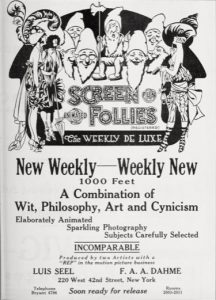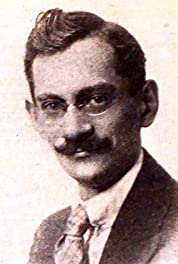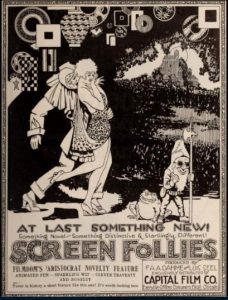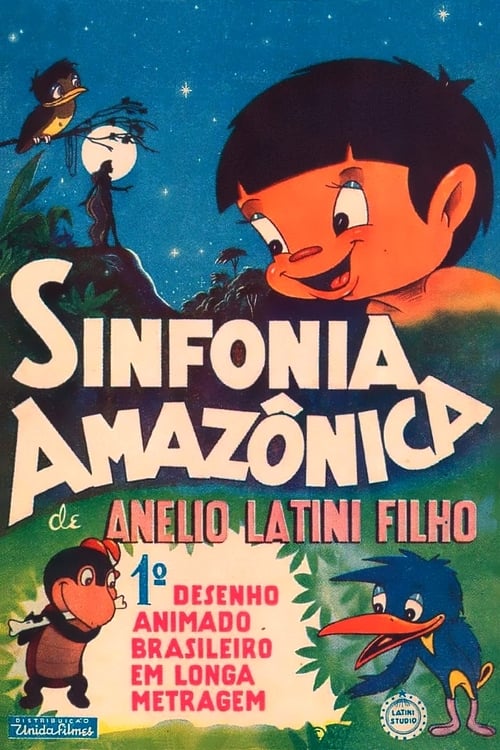
An image from “Kaiser” (1917)
In Brazil, as in other countries, animation was principally seen in advertising vignettes, beginning in 1907. The first autonomous short was a satire of the Kaiser, made in 1917, the year Germany declared war on Brazil. Productions sporadically continued; this article is on three individuals that made long lasting impacts on the country’s early animation. Most of the films mentioned are unavailable; lost or in archives. It is my sincere hope that this piece might bring more of them to light.
 LOUIS SEEL
LOUIS SEEL
(Note: Internet data on this filmmaker is often crossed with a German painter of the same name, 1881-1958.)
Louis (aka Luiz, Luis) Seel’s path crossed with several greats in the animation field, but he never found a permanent home of his own. He was industrious and remains somewhat mysterious; at times even sinister.
Seel was born in America in 1890, and by 1915 was animating at the studio that did MUTT & JEFF cartoons. He relocated to Germany in 1919, first working for the Moeve-Film studio in Munich. Advertising from 1920 promotes a series of two SCREEN FOLLIES reels “produced by F A A Dahme and Luis Seel”, distributed by Capital Film Co. of Chicago.
The ad teases with “Filmdom’s ‘Aristocrat Novelty Feature [sic]” and “Something Novel…Something Distinctive & Startlingly Different!” (the word ‘novel’ is in fact dropped thrice), but the only hint as to its content is “Animated Fun”. Indeed, the artwork suggests nothing of the standard cartoon content of the time; it is a modish illustration of a clown, a dancer and a gnome. It suggests the spicy content his studio would produce throughout the Roaring Twenties, initially from his own studio, Louis Seel & Co., formed in a partnership with Oscar Fischinger in 1921,

Luis Seel
In 1924, Seel started another company, Louis-Seel-Incorporated, in New York with a subsidiary in Munich, Louis-Seel-GmbH. For the next two years, he made the WIENER BILDERBOGEN (“Vienna Picturebook”) series, also called LOUIS SEEL’S FILMDERBOGEN (“Louis Seel Film Album”), himself directing. Julius Pinschewer and Oskar Fischinger, both enjoying success as advertising and experimental animation, served respectively as producer and art director.
From 1926, Seel’s filmography continued with more conventional titles such as THE FLYING CARPET and PIRATES BOLD.
In Brazil in 1928, Seel is recorded as having produced an animated series of six, Brazil ANIMADO, with Belmonte, a caricaturist.
 Several sites credit Seel as the director of a live action exploitation film, VENENO BRANCO (“White Poison”, or “Cocaine”, 1929). As his wife and model, Olivette Thomas, is a member of the cast, it is not inconceivable, but, aside from a creditless press advertisement drawn with the same florid approach as the 1920 SCREEN FOLLIES ad, I have no documentation of it.
Several sites credit Seel as the director of a live action exploitation film, VENENO BRANCO (“White Poison”, or “Cocaine”, 1929). As his wife and model, Olivette Thomas, is a member of the cast, it is not inconceivable, but, aside from a creditless press advertisement drawn with the same florid approach as the 1920 SCREEN FOLLIES ad, I have no documentation of it.
A trickle of animated shorts are documented from his Brazilian period. By 1940, Seel was back in Germany, then at the height of its feverishness to discover its own Walt Disney to snuff out what it saw as America’s cultural stranglehold. But Seel’s projects were repeatedly foiled by the machinations of nazi government. He was ousted from Tobis Filmkunst’s first animated project, RUBENZAHL, by the Ministry of Enlightenment and Propaganda, who favored a more “hands-on” approach. Then an attempt to found his own studio was halted by Goebbels’ jealous assistant, the head of Deutsche Kulturfilm Zentrale, who in fact had Seel blacklisted from heading any future projects. Seel’s attempts to start over in Prague apparently did not meet with great success. After that, I know nothing.
Three samples of his work:
WIENER BILDERBOGEN #1 (1924)
Opening with the announcement“Dedicated to the Viennese”, which is followed by the title “The Miracle of The Radio as Reported from The New York Radio Exhibition”, Seel reveals a flapper’s morning antics modernized through the Miracles of Radio Control and Television.
This short is in certain ways OUT OF THE INKWELL with an erotic twist. Seel’s hand draws a flapper girl, posed by his wife, actress Olivette Thomas, who is given a screen credit as “My Model”. She parades through elegant (find another adjective!) states of undress, her nudity shielded by the artist’s hand at the most provocative intervals. Drawings are the height of Art Deco modernity.
UGLY APE, PRETTY APE (fragment, circa 1935)
A minute from a cartoon done with Joao Stamato. This film is assigned various years, but the fleeting reference to Popeye (who had made his animated debut in 1933) and the design of Mickey suggest the mid 1930s, even though it exhibits a stark, stilted black and white technique that suggests the comic strip style of much older films. It would be a mistake to date a cartoon by the technical standards of the United States. Most countries were about ten years behind that standard.
FRIVOLITA (1937?)
“Designs by Luis Seel.”; the end title bears the legend “A Seel-Thomas Film”. FRIVOLITA is often documented as being from 1930, but “Boo Hoo”, the Fats Waller record pirated for its existent soundtrack, dates from 1937.
In what appears to be another newsreel supplement, Seel returns to his favorite motif, a chic chick awakening in an Art Deco Bizarre environment. Extensively rotoscoped and animated with a combination of cel techniques and maneuvered cutouts. Seel’s graphic elegance is what makes this stand out.
LUIZ SA
Born in Cerara in 1907, Sa was already enjoying a tremendous success in magazine cartoons, comics and advertising mascots when he was bitten by the animation bug. Between 1938 and 1939, he produced and directed a series of cartoon films featuring an anthropomorphic cat, THE ADVENTURES OF VIRGULINO.
Here is a fragment of a documentary on Sa, with some painfully racist examples of his work in print.
VIRGULINO’S CATCH (1939)
In 1939, Walt Disney made his first visit to Brazil to promote cooperation between the three Americas (The Three Caballeros) during times of international tensions, and was also enthusiastically studying and scouting for native cartooning talent. His was a very popular presence in South America; every cartoonist sought an audience with him, including Luiz Sa. However, Brazil’s DIP (Department of Press and Propaganda) forbade Sa to show Disney his films. Sa’s rudimentary efforts were okay enough to be shown on home territory, but that they should represent the nation’s skill to Walt Disney was out of the question. Mortified, Sa returned to his career in print, selling the reels of film he had produced to a projector store that cut them into sections and used them as product giveaways. This fragment was discovered by a film collector in 1975. Still a a nation’s treasure, Sa died in 1979 .
ANELIO LATINI, FILHO
Anelio Latini, Filho (1926-1986) loved animation so much he drew Brazil’s first feature length cartoon at home alone.
The son of a painter, Anelio Latini, Filho was another self-taught animator. He and his brother, Mario, had created their first short, AZARES DE LULU (“Lulu’s Adventures”) in 1940. From a screenplay Anelio had commissioned himself, he drew SINFONIA AMAZONICA (“Amazon Symphony”) between 1946 and 1953. The feature scored a hit in Brazil, but not a profit. He left a second feature unfinished, returning to painting and illustration, and making several live action documentaries.
AMAZON SYMPHONY (1953)
The film is an odyssey based on several episodes of Brazilian folklore, its format reflecting the success of Disney’s South America-themed pictures. (In Spain, Arturo Moreno made a similar feature, Alegres Vacaciones, in 1948.) Working on challenging resources, it unfortunately had to be filmed without color, and was accompanied by pre-recorded classical music, save for an original samba scored by brother Mario, which may be considered the highlight of the film.



 Milton Knight is an artist of wide experience, having been involved in comics, illustration, animation and painting. You’ve seen his animation in Sonic The Hedgehog, The Twisted Tales of Felix The Cat and in Ralph Bakshi’s Cool World. His comic art has graced Mighty Mouse, Teenage Mutant Ninja Turtles and his own book, Hugo. Knight has also recently completed his first novel. Visit his blog at
Milton Knight is an artist of wide experience, having been involved in comics, illustration, animation and painting. You’ve seen his animation in Sonic The Hedgehog, The Twisted Tales of Felix The Cat and in Ralph Bakshi’s Cool World. His comic art has graced Mighty Mouse, Teenage Mutant Ninja Turtles and his own book, Hugo. Knight has also recently completed his first novel. Visit his blog at 











































Muito obrigado, Senhor Knight! To you I raise my glass of cachaça! (Or rather I would, if I had any.) Never having seen any Brazilian cartoon other than “Sea Princesses”, I was fascinated by this look at the country’s early animation history. I would love to see more Virgulino cartoons, if any have survived in full.
The dedication in WIENER BILDERBOGEN #1 — “Der Wienerin gewidmet” — actually means “Dedicated to the Viennese woman,” singular.
Luiz Sa was born in Fortaleza, one of Brazil’s biggest cities, capital of the northeastern state of Ceara (not “Cerara”).
I wish “Amazon Symphony” was in colour, subtitled, and had a through-composed musical score. But it’s still an impressive piece of work.
I hope you’re going to bring Guimaraes Productions in a future post – a studio that Disney outsourced to a few times during the ’90s.
Thank you very much for the article, Mr. Knight! As a Brazilian citizen, I can say that I’m proud!
the animation industry here in Brazil will only start to emerge in full force in the early 2000s, when computers made production processes easier.
Before that, between the 1950s, with the emergence of TV in Brazil, until the 1990s, much of the animation produced was exclusively for advertising. However, some animators managed to produce short and feature film animations.
Thanks Milton, it’s great to be schooled in this aspect of animation history, all new to me.
FYI: Münchener Bilderbogen were individually sold sheets of (proto) comics & other paper novelties produced in Munich (not connected to any news media) and later recycled in album format. They were the training ground for Willem Busch, Lothar Meggandorfer & many other early, important comics artists.
Professor Knight, thanks for presenting one of the most informative posts I’ve ever seen on Cartoon Research! The history of Brazilian animation is very interesting, they managed to produce films with little or no experience in animation and nearly zero knowledge of timing or animation mechanics. I’m only halfway through Filho’s Sinfonia Amazonica, it’s pretty slow going. So far he’s nearly copied Fantasia, especially the Nutcracker Suite sequence, and was inspired by Snow White’s scary forest adventures to create the interactions between the monsters, owls, giant snakes and Brazilian Indians in the swamps of the Amazon. The film begins to get interesting about 20 minutes in. I’ll watch the rest of it when I have time. Your tales of Luiz Sa and Louis Seel were very interesting, especially the story of Luiz Sa’s attempted audience with Walt Disney. As animators, they were good tracers of photographs, not much life or character to their stuff. Thanks again, Prof!
Just a clarification: “Filho” (from the Latin filius) is the Portuguese word for “son”, here equivalent to “Junior”. It’s not part of Latini’s surname.
Thanks, Paul. I’ll ask Jerry if there’s still a chance to correct the article.
OK, Paul thanks for the correction on Anelio Latini’s name. The last half hour or so of the feature was the most interesting. I wonder who that porpoise (?) was supposed to represent. Some kind of guardian angel I suppose. The dance by the natives around the fire put me in mind of Chuck Jones’ cartoon “Mighty Hunters”. The rainbow sequence near the end was looking over it’s shoulder at the “Pastoral Symphony” sequence from “Fantasia”. I don’t know who the semi-naked lady in the canoe was. The dancing ladies in the moonlight looked a lot like Hugh Harman;s “The Blue Danube”. And what the heck was a swamp lion doing wearing a bra and panties? This feature is certainly “mondo curioso” if you’ll excuse a made-up Spanish/Brazilian expression.
Oh, and I forgot to mention the samba sequence did get a bit more lively. It looked like Latini was learning to use the rotoscope and used it to create samba dancing swamp animals.
While digging, I found the full (?) version of the Luiz Sa documentary which you showed a fragment of in the article: https://www.youtube.com/watch?v=RT8wsmmikls
A bit late, but for German animation, including the works of Louis Seel there, take a look at the “Chronology of animated film in Germany” (in German only, but with Google Translate or the likes this shouldn’t be a problem):
https://www.diaf.de/forschung/chronologie-zum-animationsfilm-in-deutschland/
The section 1920-1929 actually begins with a long quote from a 1940 article by Seel.
Great post.
By the way, Disney’s trip to Brazil “to promote cooperation between the three Americas” was in 1941, not 1939.
Great article!
The name of the state where Luiz Sa was born is not Cerara or Ceara, but rather Ceará. Luiz himself speaks the word in the video.
“Filho” really means “son”, but many Brazilian men give their own names to their male children, and add the word “Filho” into the kid’s name to differentiate. It’s also common to see the word “Neto”, which means “grandson”, in Brazilian male names.
Almost 2 years later, i came here to say that “Ugly Ape, Pretty Ape” has been found in its entirety, and can be watched here: https://archive.org/details/macaco-feio-macaco-bonito